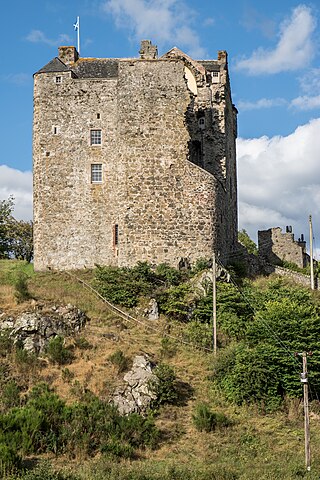
Neidpath Castle is an L-plan rubble-built tower house, overlooking the River Tweed about 1 mile (1.6 km) west of Peebles in the Borders of Scotland. The castle is both a wedding venue and filming location and can be viewed by appointment.

Castle Fraser is the most elaborate Z-plan castle in Scotland and one of the grandest 'Castles of Mar'. It is located near Kemnay in the Aberdeenshire region of Scotland. The castle stands in over 300 acres (1.2 km2) of landscaped grounds, woodland and farmland which includes a walled kitchen garden of the 19th century. There is archaeological evidence of an older square tower dating from around 1400 or 1500 within the current construction. The castle is a Category A listed building and the grounds are included in the Inventory of Gardens and Designed Landscapes in Scotland.

Drum Castle is a castle near Drumoak in Aberdeenshire, Scotland. For centuries it was the seat of the chief of Clan Irvine. The place-name Drum is derived from Gaelic druim, 'ridge'. The site is located approximately 6+1⁄2 miles northeast of Banchory and 3 miles west of Peterculter. The property is now owned by the National Trust for Scotland and is open to the public.

Crathes Castle is a 16th-century castle near Banchory in the Aberdeenshire region of Scotland. It is in the historic county of Kincardineshire. This harled castle was built by the Burnetts of Leys and was held in that family for almost 400 years. The castle and grounds are owned and managed by the National Trust for Scotland and are open to the public.

Craigievar Castle is a pinkish harled castle or fortified country house 6 miles (9.7 km) south of Alford, Aberdeenshire, Scotland. It was the seat of Clan Sempill and the Forbes family resided here for 350 years until 1963, when the property was given to the National Trust for Scotland by William Forbes-Sempill, 19th Lord Sempill, in the 1960s. The setting is among scenic rolling foothills of the Grampian Mountains, and the contrast of its massive lower storey structure to the finely sculpted multiple turrets, gargoyles and high corbelling work to create a classic fairytale appearance.

Fyvie Castle is a castle in the village of Fyvie, near Turriff in Aberdeenshire, Scotland.

Delgatie Castle is a castle near Turriff, in Aberdeenshire, Scotland.
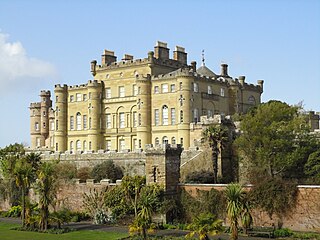
Culzean Castle is a castle overlooking the Firth of Clyde, near Maybole, Carrick, in South Ayrshire, on the west coast of Scotland. It is the former home of the Marquess of Ailsa, the chief of Clan Kennedy, but is now owned by the National Trust for Scotland. The clifftop castle lies within the Culzean Castle Country Park and is opened to the public. From 1972 until 2015, an illustration of the castle was featured on the reverse side of five pound notes issued by the Royal Bank of Scotland.
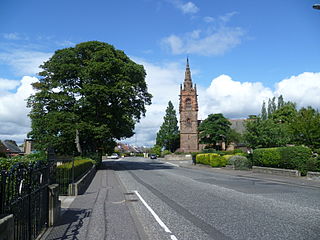
Craiglockhart is a suburb in the south west of Edinburgh, Scotland, lying between Colinton to the south, Morningside to the east Merchiston to the north east, and Longstone and Kingsknowe to the west. The Water of Leith is also to the west.

Elvaston Castle is a stately home in Elvaston, Derbyshire, England. The Gothic Revival castle and surrounding parkland is run and owned by Derbyshire County Council as a country park known as Elvaston Castle Country Park. The country park has 200 acres (0.81 km2) of woodlands, parkland and formal gardens.
The 109th (Aberdeenshire) Regiment of Foot was an infantry regiment of the British Army from 1794 to 1795. Raised by Alexander Leith Hay for service in the French Revolutionary Wars the regiment was briefly deployed in Jersey before it was disbanded in England and its men sent to reinforce the 53rd (Shropshire) Regiment of Foot. The disbandment was controversial as Leith-Hay believed it contravened an assurance given to him in his original letter of service to raise the regiment.
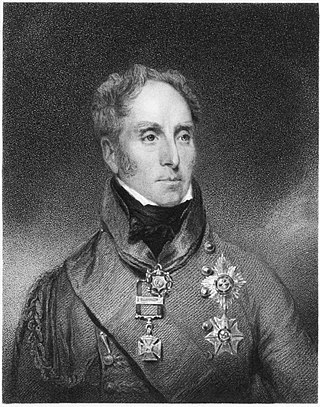
Lieutenant-General Sir James Leith was a Scottish soldier who served in the British Army, commanding the 5th Division in the Duke of Wellington's Anglo-Portuguese Army at several critical battles during the Peninsular War between 1810 and 1813.
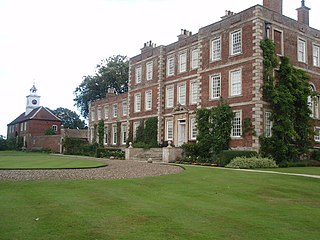
Gunby Hall is a country house in Gunby, near Spilsby, in Lincolnshire, England, reached by a half mile long private drive. The Estate comprises the 42-room Gunby Hall, listed Grade I, a clocktower, listed Grade II* and a carriage house and stable block which are listed Grade II. In 1944 the trustees of the Gunby Hall Estate, Lady Montgomery-Massingberd, Major Norman Leith-Hay-Clarke and Field Marshal Sir Archibald Montgomery-Massingberd, gave the house to the National Trust together with its contents and some 1,500 acres of land.

There are a number of reportedly haunted locations in Scotland.
Kennethmont is a village in the Marr area of Aberdeenshire, Scotland, approximately 8 miles (13 km) south of Huntly.
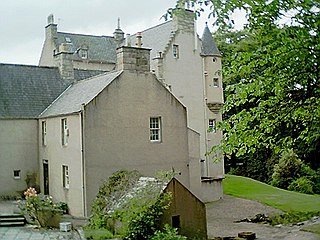
Lickleyhead Castle is a well-restored L-plan castle, dating from around 1600, a little south of Auchleven, by the banks of the Gadie Burn, in Aberdeenshire, Scotland.

Elizabeth Byrd was an American author. Her main body of work is historical fiction, and her most successful novel is Immortal Queen, a historical romance about Mary, Queen of Scots. Nine of her thirteen novels were published while she was living in Scotland.
Walter Schomberg Hepburn Scott (1910–1998) was a Scottish architect specialising in building restoration. From 1950 until 1975, he did multiple projects for the National Trust of Scotland.

Woodhill House is a large office development on Westburn Road in Aberdeen, Scotland. It was built as the headquarters of Grampian Regional Council in 1977 and then became the offices and meeting place of Aberdeenshire Council in 1996.

















